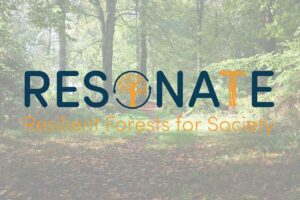 Algonquin Bound
Algonquin Bound
Prince of Wales Forest Leadership Award winner Keira Tedd left for her placement at Algonquin Provincial Park in Ontario, Canada, in June. Since then she’s discovered the diverse forestry activities of the forest authority, including silviculture, tourism and logging, as well as meeting some unusual wildlife…
Hello there! My name is Keira Tedd, a recent graduate of the National School of Forestry at the University of Cumbria. Prior to the past four years spent obtaining my BSc Honours degree in Forest and Woodland Management, I had no experience with the forest industry. Four years, and a sharp learning curve later, I was ecstatic to hear that I had been selected for the Prince of Wales Forest Leadership Award and that Algonquin Park was to be my placement.
Algonquin Provincial Park
Algonquin was originally given its status as a provincial park in 1893. Since then it has become famed for its networks of lakes, portages and hiking trails as well as the breath-taking fall colours, which attract thousands of tourists every year (I have my fingers crossed that I’ll get to see them before I head home!). The Algonquin Forestry Authority (celebrating its 40th anniversary this year) is the governmental organisation tasked with managing the forests of the park.
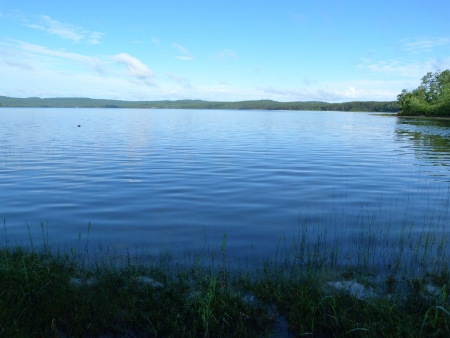
One of the many lakes within Algonquin Provincial Park
After my first month in the beautiful Algonquin Park (and after donating several pints of blood to the local insect population), I can honestly say that this is quite possibly one of the most fantastic opportunities I’ve ever been given! The hard slog to get everything prepared for the placement and the social trauma that comes from putting a country lass into big cities (even if only for a day or two) has been worth it. The team at the Algonquin Forestry Authority have been amazing, friendly and a veritable minefield of experience and knowledge (although the correct use of ‘ey’ is still beyond my comprehension)!
I have found myself making a great deal of comparisons between forestry in the Algonquin Provincial Park and the UK forestry I have spent the past four years engaging with. So without further ado, here are some of the things I’ve had the opportunity to explore in the last few weeks.
Silviculture
Having developed a keen interest in alternative silviculture/ Continuous Cover Forestry (CCF) whilst at university, the selection and shelterwood systems applied by the AFA have me in my element! The knowledge and skill applied to the management of the forest is amazing and it’s been fantastic to be able to pick peoples brains about the opportunities and challenges that the AFA face by applying this type of silviculture. Due to past glacial activity, the park has two different ‘zones’. The west is home to the hardwood forests of the upland areas (also known as the dome) whilst the east sides flat and sandy planes are dominated by pine. Single tree selection is the dominant management type in the western broadleaves whilst shelterwood systems are adopted in the pine to the east.
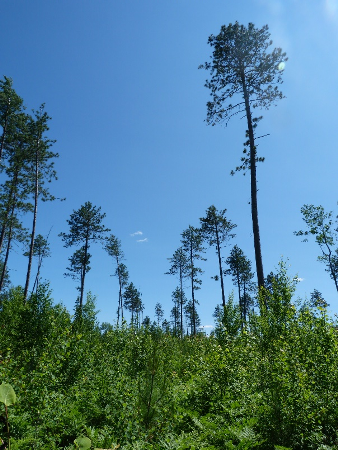
The levels of regeneration are unlike anything I’ve experienced during my time in the forest industry. Very different to the challenges faced in the UK where establishing the next rotation using natural regeneration can be unreliable. That’s not to say that planting isn’t used for establishment in Algonquin. In areas where stocking density is low or the regenerating species is undesirable, seedlings are planted. There are also some examples of clearcutting in the park, but even these look very different from the upland harvesting sites of Britain (and that big area of blue sky is not what I’m referring to). Standards are left as seed trees for the next rotation and regeneration carpets the site! This particular cut type is usually used for red pine (Pinus resinosa) stands, as this species is shade intolerant and requires heat in order to successfully seed.
Tree Marking
Tree marking crews mark the trees for extraction in advance of operations. The marking is then audited to ensure that the correct basal area is retained (it seems that the average in the broadleaved selection areas is 30% removal) and that the trees marked for removal have been appropriately selected (More info in next blog!). These marks indicate to the operator of the feller-buncher/chainsaw, which trees should be cut.
Logging in the Park
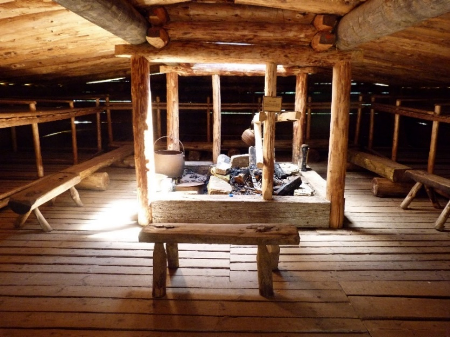
The logger’s bunkhouse at the Logging Museum in the Park
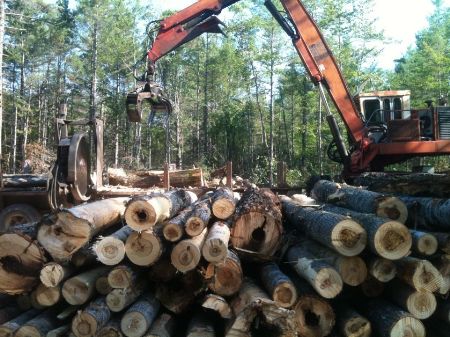
Processor cutting tree lengths into products at the roadside landing on site
So far I’ve had the opportunity to explore a few active logging sites within the park and my initial impression was how incredibly busy they are. At any one time there are several different pieces of machinery slowly cutting, transporting and processing the timber. My experiences in the UK have been predominantly with a harvester/forwarder teams so it was a fantastic opportunity to glean an understanding on other potential logging methods. The AFA contractors who log use feller-bunchers to cut whole tree lengths before skidders move them to the roadside.
As the AFA uses a variety of selection and shelterwood silviculture, it was amazing to see the skill the operators possessed as they moved these large bulky machines and tree lengths around whilst keeping damage to the residual forest to a minimum. Here a processor, or slasher, cuts and sorts the timber into different products before they are loaded and transported to the sawmills. Interestingly, the majority of the mills that are supplied with timber from the park are located adjacent to the boundaries of the park.
It was interesting to learn that less than 55% of the total 7,635km2 that makes up Algonquin Park is available to be harvested and that only around 1% is harvested in a year.
The Weird and Wonderful Wildlife of Algonquin Provincial Park
The variety of wildlife housed by Algonquin Park is truly astounding! So far I’ve been lucky enough to see (and even photograph) some of the parks inhabitants. On a prior trip to Canada, my family and I were fortunate enough to see a variety of bears but no moose. I was very thankful, then, that this big guy was kind enough to pose roadside for a photo opportunity!
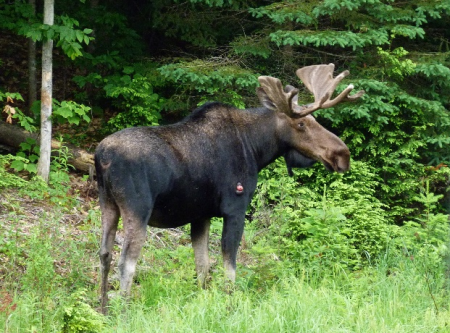
There’s a moose loose aboot the hoose! This big fella was kind enough to pose for a photo by the side of Highway 60 which runs through an area of the park. It’s truly amazing how such a large mammal has such long, spindly legs!
The AFA has a range of measures in place in order to ensure that any forest operations within the park keep disturbance to habitat and wildlife to a minimum. Buffers are established around watercourses in order to prevent sedimentation and pollution and reserves are placed on any areas used or occupied by wildlife.
To Summarise…
This is just a brief summary on the areas I’ve been focusing on so far. There are many more plans in the works for the next two months including tree marking, silvicultural effectiveness monitoring, logger’s day and much, much more!
If anyone wishes to know more about the Algonquin Forestry Authority or the Prince of Wales Forest Leadership Award, I would suggest checking out the web-links below.
www.charteredforesters.org/education-careers-and-cpd/forest-leadership-award
www.cif-ifc.org/wp-content/uploads/2014/09/Press-Release-for-Publication-Feb-24-Final.pdf
Or if you have any questions about what I’m up to, how to apply for the Prince of Wales FLA etc. you can contact me via social media.
Social Media Links
uk.linkedin.com/pub/keira-tedd/a6/a49/b65




